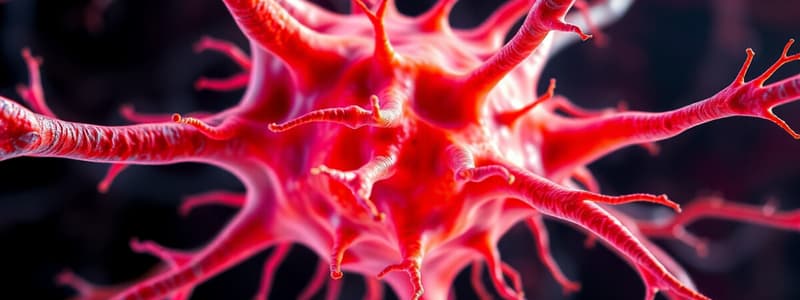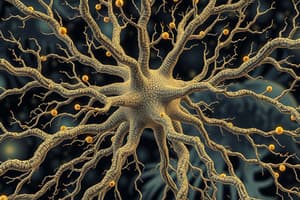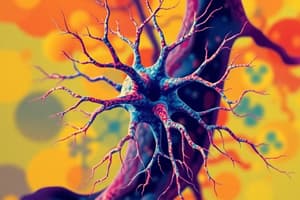Podcast
Questions and Answers
What is the primary role of dendrites in a neuron?
What is the primary role of dendrites in a neuron?
- Transmit signals to other neurons
- Protect the neuron from damage
- Receive signals from other neurons (correct)
- Release neurotransmitters
Which brain area is identified as essential for speech production?
Which brain area is identified as essential for speech production?
- Broca’s area (correct)
- Cerebellum
- Wernicke’s area
- Hippocampus
In the context of cognitive processes, what does 'distributed representation' refer to?
In the context of cognitive processes, what does 'distributed representation' refer to?
- A method to measure brain blood flow
- Cognitive functions being stored in single brain areas
- Involvement of multiple brain regions in cognitive tasks (correct)
- Specific areas being responsible for emotion only
What type of brain activity does EEG measure?
What type of brain activity does EEG measure?
What is the function of the synapse in neuronal communication?
What is the function of the synapse in neuronal communication?
What characterizes the Sensory Store in memory?
What characterizes the Sensory Store in memory?
Which Gestalt principle explains why we group nearby objects together?
Which Gestalt principle explains why we group nearby objects together?
Which processing method involves building perception from raw sensory input?
Which processing method involves building perception from raw sensory input?
In ambiguous images, what influences what a person perceives?
In ambiguous images, what influences what a person perceives?
What is essential for effectively catching a ball?
What is essential for effectively catching a ball?
What is a characteristic of iconic memory within the sensory store?
What is a characteristic of iconic memory within the sensory store?
Which principle of Gestalt psychology describes how we perceive lines as continuous even when they are interrupted?
Which principle of Gestalt psychology describes how we perceive lines as continuous even when they are interrupted?
In top-down processing, perception is primarily influenced by which of the following?
In top-down processing, perception is primarily influenced by which of the following?
What example illustrates bottom-up processing?
What example illustrates bottom-up processing?
Which of the following links perception to action in a meaningful way?
Which of the following links perception to action in a meaningful way?
Flashcards are hidden until you start studying
Study Notes
Neuron Structure and Functioning
- Neurons are specialized nerve cells responsible for transmitting information via electrical and chemical signals.
- Key components include:
- Soma: The cell body that houses the nucleus and metabolic machinery.
- Dendrites: Branch-like structures that receive incoming signals from other neurons.
- Axon: A long extension that transmits signals away from the soma to other neurons.
- Synapse: The junction between neurons where neurotransmitters are released to facilitate communication.
- The transmission process occurs as follows:
- Signals are received by dendrites, processed in the soma, and then conducted through the axon to the synapse.
- An example is the visual cortex, where neurons process signals from the retina, enabling the perception of objects.
Localization of Cognitive Functions
- Localization refers to the concept that specific cognitive functions are associated with distinct areas of the brain.
- A prominent example is Broca’s area, located in the left frontal lobe, which plays a crucial role in language production and speech.
Distributed Representation
- Distributed representation suggests that cognitive processes rely on networks of brain areas rather than individual locations working in isolation.
- An illustration of this is facial recognition, which involves multiple regions: the temporal lobe handles visual processing, while other areas contribute to memory and emotional responses.
Methods of Assessing Brain Functioning and Cognition
- fMRI (Functional Magnetic Resonance Imaging): An imaging technique that detects changes in blood flow to indicate brain activity, providing insights into cerebral function.
- EEG (Electroencephalography): A method that measures electrical activity in the brain by placing electrodes on the scalp, capturing real-time brain wave patterns.
- TMS (Transcranial Magnetic Stimulation): A technique that uses magnetic fields to temporarily disrupt normal brain activity, helping researchers understand the effects on cognitive processes.
Sensory Store
- Sensory Store holds sensory information for milliseconds, serving as the initial memory stage.
- Iconic memory is a component of the sensory store that retains visual images for a brief moment.
Assumptions from the Environment
- Perception is shaped by assumptions based on prior experiences and knowledge.
- An example includes interpreting shadows as obstructions of light due to past encounters.
Gestalt Principles of Organization
- Gestalt Principles help in organizing visual stimuli into cohesive patterns.
- Proximity principle dictates that objects physically closer are perceived as related.
- Similarity principle suggests that items sharing traits are grouped together.
- Closure principle enables the mind to complete incomplete figures to form recognizable shapes.
- Continuity principle leads to perceiving lines as smooth and continuous, even if they are interrupted.
Bottom-Up and Top-Down Processing
- Bottom-Up Processing begins with raw sensory data, forming a higher-level understanding, as seen in the experience of tasting new flavors.
- Top-Down Processing relies on cognitive factors like expectations and former knowledge, aiding in recognizing familiar entities, such as identifying a blurred image as a face.
Evidence for Top-Down Processing Contributions to Perception
- Ambiguous images, like the duck/rabbit illustration, demonstrate that perception can shift based on prior knowledge.
- Research indicates context effects where expectations alter the perception of words, especially in noisy contexts.
Perception and Action
- Perception is fundamentally connected to action, facilitating interaction with the environment.
- For example, catching a ball requires perceiving its path and coordinating physical movements accordingly.
Sensory Store
- Sensory Store holds sensory information for milliseconds, serving as the initial memory stage.
- Iconic memory is a component of the sensory store that retains visual images for a brief moment.
Assumptions from the Environment
- Perception is shaped by assumptions based on prior experiences and knowledge.
- An example includes interpreting shadows as obstructions of light due to past encounters.
Gestalt Principles of Organization
- Gestalt Principles help in organizing visual stimuli into cohesive patterns.
- Proximity principle dictates that objects physically closer are perceived as related.
- Similarity principle suggests that items sharing traits are grouped together.
- Closure principle enables the mind to complete incomplete figures to form recognizable shapes.
- Continuity principle leads to perceiving lines as smooth and continuous, even if they are interrupted.
Bottom-Up and Top-Down Processing
- Bottom-Up Processing begins with raw sensory data, forming a higher-level understanding, as seen in the experience of tasting new flavors.
- Top-Down Processing relies on cognitive factors like expectations and former knowledge, aiding in recognizing familiar entities, such as identifying a blurred image as a face.
Evidence for Top-Down Processing Contributions to Perception
- Ambiguous images, like the duck/rabbit illustration, demonstrate that perception can shift based on prior knowledge.
- Research indicates context effects where expectations alter the perception of words, especially in noisy contexts.
Perception and Action
- Perception is fundamentally connected to action, facilitating interaction with the environment.
- For example, catching a ball requires perceiving its path and coordinating physical movements accordingly.
Studying That Suits You
Use AI to generate personalized quizzes and flashcards to suit your learning preferences.




